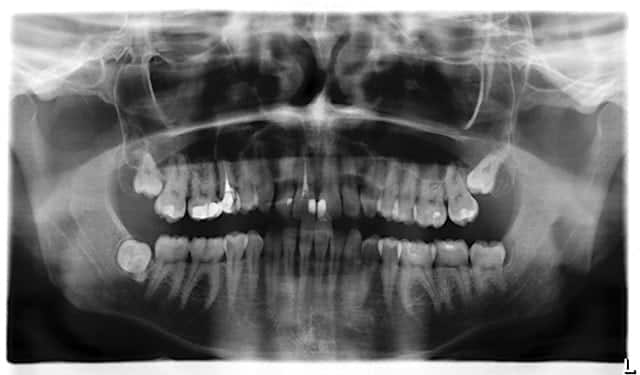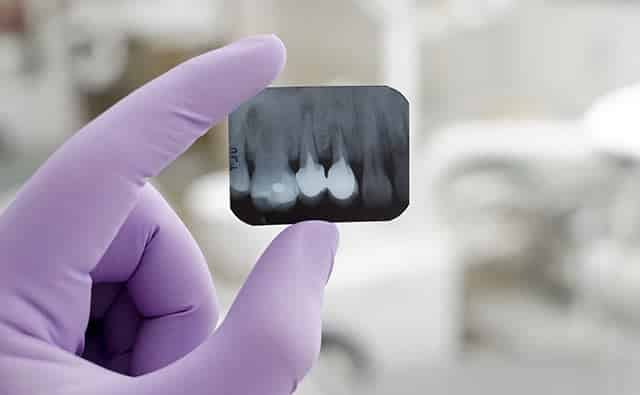Common Dental X-Rays and Their Uses
Once in a while at one of your regular dental cleanings, your hygienist will need to take dental x-rays of your teeth. Other times, if you have a dental issue such as a tooth ache or loose tooth, your dentist will require one or more different types of x-rays. Why are there so many types? What are each used for?
Panoramic X-Ray
To take a panoramic dental x-ray, clinical staff will have you stand or sit at a large machine. After draping a lead vest around you, the staff member will step out of the room and a part of the machine will spin completely around your head, capturing what is called a panoramic x-ray. Unlike other dental x-rays, a panoramic x-ray is quite comfortable, quick, and only needs to be taken once every three to five years unless you are about to pursue orthodontic treatment or if you are in need of oral surgery.
Why It’s Needed
Typically our dental staff will take a panoramic x-ray on new patients at their very first visit unless they’ve brought one with them or had an old one transferred from their last office that is no more than 3 years old (or sometimes 5, depending on when the x-ray was taken and your dental insurance coverage). This type of dental x-ray is very important for many reasons.
The 2D panoramic image shows a full display of your entire mouth – all of your teeth and both jawbones – along with your sinus cavities and surrounding bone. This is a helpful tool for dentists to spot many different health issues:
- oral cysts
- bone loss
- abscesses
- impacted teeth
- inflamed sinuses
- tumors
- TMJ
Most insurance companies only cover a panoramic x-ray once every three or five years, so it is important that you understand your coverage and make sure to take note of the date your last one was taken. If more than one is taking within your plan’s waiting period it will not be covered.
Full Mouth X-Ray
A full mouth x-ray is sort of like a panoramic x-ray, only broken into 14-16 individual frames instead of one large image. These dental x-rays are updated once every 3 to 5 years, depending on your oral health.
Why It’s Needed
Most of the time, a full mouth x-ray, just like a panoramic, is taken at your initial visit at a new dental office, and then not updated again until a few years later. Unlike a panoramic, however, this type of x-ray helps your dentist see tooth structure of each individual tooth in your mouth, as well as look in between all of your teeth as well.
Bitewing X-Rays
These important dental x-rays are much simpler to take than a full mouth series of x-rays. The patient bites down on a plastic piece that is holding the x-ray sensor, and it goes between your back molars and front molars on each side, making it a total of four individual x-rays. These are typically only updated once per year at one of your regular cleanings.
Why It’s Needed
Bitewing x-rays show in between both your top and bottom molars at once, making it easy for your dentist to not only spot decay in between them, but to see how well they come together and line up, too. This type of dental x-ray also helps show any bone loss that could have been caused by infection or gum disease, and helps your dentist diagnose a multitude of dental problems efficiently.
Periapical X-Ray
If you’ve ever had a toothache or facial swelling, your dentist will have needed to take a special type of x-ray to best diagnose what is happening to your tooth or teeth. They are small, single x-rays that only need to be taken once.
Why It’s Needed
Periapical are dental x-rays that capture an entire tooth from cusp to root tip. They can be slightly uncomfortable, but are essential to the health of many patients. By being able to see the entire tooth, dentists are able to determine if you have an infection in your tooth. As infections are extremely dangerous, it is important you let your dentist take this type of x-ray at any sign of discomfort or swelling.
Dental X-Rays Help Us To Help You
Making sure you are up to date on your dental x-rays is one of our many jobs. As you can see, each type of x-ray is imperative to us as we require them to detect infections, decay and defects that can cause you infection and disease that, if left untreated, can also cause you a pretty penny if not addressed in a timely matter. Our staff is trained to know when to take what type of x-ray, and how often each are needed is based on your oral health history and amount of decay present in your mouth. Without dental x-rays, we could not find issues when they are small – before they start to hurt you – and thus could not treat you efficiently. Because they are essential to proper treatment and cost effective, keeping up on your dental x-rays is key to maintaining good oral health.




